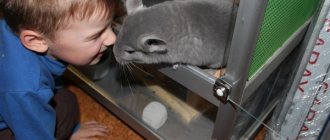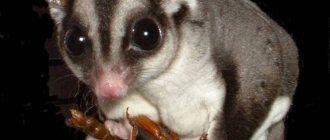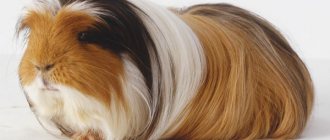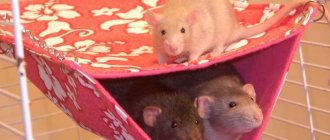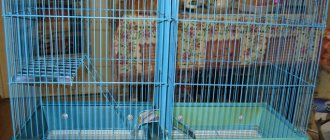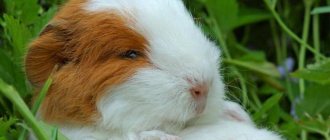Chinchillas are originally from South America. It was from there that they were imported into our country. These cute, fluffy animals have not left many people indifferent, as they are quite attractive and friendly, so it is not surprising that these pets are on a par with domestic cats in popularity. These animals are quite cute in appearance, small in size, they resemble a squirrel in appearance, but their ears are shaped like a hare. Chinchillas are herbivorous rodents.
There are two varieties of these pets - short-tailed chinchillas and long-tailed common chinchillas; this species is purposefully bred for fur in a special territory, or kept at home as pets. Thanks to their thick, rich fur, chinchillas have become popular among ladies who want to own and wear a chic chinchilla fur coat. Due to the popularity of fur, the number of these pets is regularly decreasing.
Currently, due to population decline, chinchillas are listed in the Red Book as an endangered species.
At a time when South America was not fully explored, there were numerous attempts to conquer this contingent. The Spaniards often visited the coast of South America. They liked the nature, the climate and especially the clothes of the aborigines living there. The Spaniards really liked clothes made of warm fur and they began to make clothes and hats from chinchilla fur. In those days, there was a tribe called “Chinchas”, in honor of which the Spaniards gave the name “chinchilla” to fur.
When fur was exported en masse from South American soil to Europe, the number of chinchillas was in great danger and on the verge of extinction, since there were a lot of hunters for them precisely because of their rich fur. In order to protect these animals from extinction, it was decided to transfer them to Europe, but people did not know exactly how to keep these animals, which is why they also died.
At first, it was decided to keep and breed these animals at home, but Matthias Chapman began breeding the animals in the States as pets with especially rich fur. By 1923, fur was particularly popular on the trade market, and Chapman set out to transfer as many more of these animals as possible for large-scale breeding.
An ordinary mining engineer was able to do this, and he bred absolutely healthy chinchilla cubs. Later, people began to follow his example, and farms appeared in the United States of America specifically breeding chinchillas.
Why does a chinchilla sleep during the day?
Under natural conditions, chinchillas sleep from sunrise to sunset. The nocturnal lifestyle is explained by the fact that at this time the main natural enemies of fluffy animals - foxes and tayras - sleep. When predator activity decreases, chinchillas wake up and leave their shelters in search of food.
It is worth noting that some predators (eagle owls, owls, buzzards) continue to hunt chinchillas even in the dark. However, at night, the furry animals, which are predominantly gray in color, blend into the surrounding landscape, making them almost invisible.
Description of the species
Classification
There are several erroneous beliefs regarding the question: what species does a chinchilla belong to? Many people think that a chinchilla is a squirrel, rabbit or rat. In fact, it is an animal related to:
- kingdom - Animals;
- tipu - Chordata;
- class - Mammals;
- infraclass - Placental;
- squad - Rodents;
- suborder - Porcupines;
- superfamily - Chinchilla-like;
- family - Chinchilla;
- family - Chinchillas.
The chinchilla genus is divided into 2 species:
- Chinchilla lanigera - small long-tailed or shore;
- Chinchilla Brevicaudata - short-tailed or large.
There are mutational species that differ in hair color.
Habitats
The homeland of the animals is South America. Long-tailed individuals are widespread in the mountains of Chile. Short-tailed - live in the Andes and northwestern Argentina.
The habitat of rodents is rocky areas, preferably northern slopes. You can meet a rodent at an altitude of up to 5,000 m. Animals choose narrow cracks and openings between stones as a home and can dig a hole.
Sleep duration
The daily routine of domestic chinchillas is not very different from the routine of their wild relatives. Because the tendency to sleep for long periods of time is inherent in furries at the genetic level.
On average, an animal's sleep at home lasts 10-12 hours.
However, this indicator can vary significantly depending on the age, health and character of the pet. For example, pregnant females, babies and adults can sleep 1-2 hours longer. And the younger generation and young animals are more active, and are awake from 12 to 14 hours a day.
Animal skeleton
The body structure of chinchillas provides them with reliable shelter and makes it possible to survive in rocky mountain conditions. The chinchilla's skeleton tapers when necessary. The need may arise when an animal hides in narrow crevices from predators and bad weather. There are 5 toes on the front legs of rodents, and 4 on the hind legs. The hind legs are longer and stronger than the front ones, which allows the animals to jump high.
How to determine the age of a chinchilla?
By external signs it is easy to determine the age of the animal. Determination is possible in several ways:
- By weight: at two months of age - up to 300 grams, at six months - up to 500 grams, per year - up to 800 grams.
- On the heels: young individuals have delicate skin on the heels. To determine age more accurately, the paws of an individual whose age is unknown can be compared with those for whom this indicator is known.
- According to the muzzle: with age, the muzzle becomes longer.
- In size: at 3-4 months a chinchilla is close to the size of a guinea pig, at 6 months and after the animal can be compared to a rabbit.
- By the color of the teeth: up to 2 months, the teeth are white, and when chinchillas grow up, the color of their teeth becomes orange.
- By sexual characteristics: in males, testicles appear by the fifth month of life; by the age of seven months, the genital organs are already easy to distinguish from female ones.
- According to the ear flaps: chinchillas with the beige gene begin to have flaps on their ears by the age of 5 months. There should be more than 2 of them per year, and in an adult at the age of 3-4 years, all the ears are covered with spots.
Places to sleep
From a physiological point of view, chinchillas can sleep anywhere. Their natural habitat is rocks. Therefore, in nature, animals sleep in crevices, where predators cannot reach them. If there are no ready-made shelters in the rocks within the range, chinchillas dig holes. In them they hide from danger and rest during the daytime.
When kept at home, naturally, fluffies do not have the opportunity to sleep in familiar conditions. In such a situation, the pet rests in a cage. Favorite places for chinchillas to sleep:
- in the house;
- in a hammock;
- on a bed of hay;
- directly on the sports equipment - in the tunnel or on the bridge.
The first days after moving, the fluffies usually sleep, huddled in the corner of the cage. When adaptation takes place, they choose another place to relax. Sometimes pets fall asleep right in the arms of their owner. This indicates complete trust and a relaxed state of the fluffy.
Advantages of an animal as a pet
When choosing an animal to live in a cage, many cannot decide for a long time which pet to prefer: a rabbit, a hamster, a rat, a chinchilla or a guinea pig. All these animals are small in size and are also very easy to care for. However, it is chinchillas that have the most impressive list of advantages. Among them are the following advantages:
- Despite their easy-going nature, chinchillas are very independent. When the owner is at work all day, the animal will not miss him too much and suffer from lack of attention.
- Chinchillas are completely odorless. The fur of these pets is anti-allergenic.
- Animals can be trained. They remember commands well if you don’t forget about training and treat them kindly.
- Chinchillas are very kind and tame pets. They will never just bite a person, unlike hamsters or guinea pigs.
- They are positive and energetic, move funny, constantly jumping and frolicking.
Don't forget about the appearance of these creatures. Surprisingly soft and plush fur, fluffy tail and cute face will not leave anyone indifferent. In addition, the animals have a cheerful and kind disposition. All this makes them ideal pets.
Sleeping positions
Chinchillas, like people, can sleep in the most bizarre positions, some of which even alarm their owners. In most cases, furries prefer to relax as follows:
- Sitting . In this case, the chinchilla can simply fold its front legs or lean them on something in the cage. This position seems uncomfortable, but the pet feels quite comfortable in it.
- On the side . It is believed that a chinchilla sleeping on its side experiences complete relaxation - it is absolutely happy and satisfied with life, and also understands that nothing threatens it. This position is a favorite for pregnant females.
- Curled up . This is how young animals usually sleep. From the outside, fluffies look like little kittens. This pose also indicates a relaxed state of the animal.
- Standing, resting your front paws on the bars of the cage . In such a case, it is safe to say that the chinchilla is tense. By falling asleep while standing, the animal does not exclude the possibility of an attack by a predator or other enemy. In this way, the fluffy is trying to save time - in case of danger, he can immediately run away.
If chinchillas are kept together, you can observe how the fluffy ones sleep tightly pressed against each other. This pose indicates a good relationship between animals.
Some pet owners are concerned that chinchillas sometimes sleep with their eyes open or half-open. However, this is quite normal. If your pet's eyes are slightly open, this indicates that he is simply dozing. Most often, a similar picture can be observed during a sharp change in weather conditions. Chinchillas are weather dependent and thus often react to changes in weather.
It is worth noting that if, in addition to open eyes during sleep, the pet exhibits additional alarming symptoms (convulsions, rapid breathing, inappropriate behavior), it must be taken to a veterinary clinic for examination.
Features of care
Chinchillas have long been tamed and feel comfortable in human society. They have a developed desire for socialization, so caring for their pet is more likely to become one of the pleasant worries than a duty.
Chinchilla diet
A balanced diet is the key to chinchilla health.
These animals eat hay, special food, nuts, barberries, rose hips, and dry bread crusts. They love fruits: plums and apples, and will not refuse raisins or dried apricots.
When purchasing food, you need to make sure that the expiration date has not expired, and also study its composition. Hay ensures the normal functioning of the animal’s intestines. In summer, the diet can be diversified with a small amount of hazel, nettle, birch and apple tree branches.
Food is placed in the feeder once a day in the evening between 17.00 and 21.00. The chinchilla also consumes chalk, replenishing the content of mineral elements in its body. You should limit the amount of high-calorie foods, the consumption of which causes obesity.
This negatively affects the reproductive ability of chinchillas.
Bathing
Chinchillas can only swim in sand
To maintain their fur in proper condition, the animals take sand baths. For such a procedure, they need a special container - a bathing suit. This is a plastic or tin container measuring 20x20x30 cm. The bathing suit is placed in the cage twice a week for 30 minutes. It is not recommended to leave the container for a longer period, as the chinchilla may mistake it for a toilet, and the sand will need to be thrown away.
In addition, frequent sand baths dry out the animal's skin. A chinchilla bathing is quite a funny sight. If possible, a transparent container should be used to allow the procedure to be observed. You can make the container yourself from a three-liter jar or pan.
The fur of these animals is highly dense, so it takes a long time to dry. Animals should not come into contact with liquid, as this can lead to their death.
Why does he sleep a lot?
On average, an adult chinchilla sleeps 10-12 hours a day. But sometimes the duration of sleep stretches to 14-16 hours. This is a big concern for novice owners. As a rule, there may be quite understandable reasons for furries resting too long:
- age up to 3 months or over 10 years;
- meteorological storms;
- phlegmatic temperament;
- unhealthy diet – containing a large amount of simple carbohydrates in the diet;
- too active games and, as a result, overwork the day before;
- stress or severe fear.
However, too much sleep can also occur due to pathological reasons. For example, a concussion as a result of a fall or other injuries, as well as certain diseases (anemia, vitamin deficiency, heart attack, stroke, neurological disorders, diabetes).
Therefore, if your pet previously slept normally, and then suddenly switched to a longer rest, you need to contact a veterinarian. Since some of the listed diseases can threaten the life of the animal. The specialist will examine the little patient and, if necessary, select the optimal treatment.
Interesting Facts
- These rodents have a well-developed cerebellum, which helps coordinate the movements of the animals. Therefore, they deftly cope with climbing rocks and other obstacles even at night.
- The chinchilla's whiskers - vibrissae - are also well developed. With their help, the animal gropes for food in the dark and hard-to-reach places.
- Chinchilla ears can detect an enemy at a fairly large distance.
- The animal's fur is unique - it is able to maintain the desired body temperature when the weather changes.
- Animals can reject fur if a predator grabs it. The new cover grows in a couple of months. The thick undercoat prevents parasites from settling on the animal’s body.
- Male chinchillas are easier to tame. The female can be offended if she is not the one picked up first.
- These animals are very clean. The animal does not make a toilet near the feeder and water bowl, and its feces do not emit an unpleasant odor.
- There is also no unpleasant odor from the animals themselves, since they do not have sweat glands on their bodies.
- Chinchillas are easy to train. Simple commands “sit” and “stand” can be mastered by any animal.
- They are nocturnal animals, so they sleep most of the day. No matter how much a chinchilla sleeps during the day, you cannot wake it up!
How to train yourself to sleep at night
Typically, a chinchilla's sleep pattern does not coincide with that of the owner and other family members. This brings significant discomfort to all household members. However, there is a way out of this situation - the fluffy one can be transferred to a “human” daily routine. There are three ways to shift your pet's schedule:
- Organize active games for the animal immediately after waking up . This way he will get tired quickly and fall asleep in a few hours. As a result, he will sleep at night with all family members. It is worth noting that in order to develop the habit of sleeping at night, you will have to entertain your chinchilla in the evenings for at least a month.
- Extend daylight hours artificially . In simple words, turn on the light in the room with the cage 2-3 hours before sunrise. This will lead to the chinchilla going to bed earlier and waking up earlier. Accordingly, subsequent sleep will also occur earlier. Gradually, in this way, it is necessary to shift the furry's schedule until it completely coincides with the daily routine of the family.
- You can “exhaust” your chinchilla by giving it the opportunity to walk around the apartment immediately after getting up in the evening . In this case, the cage will need to be closed so that the pet does not have the opportunity to return to its house and rest. After 3-4 hours of walking in open space, the animal will become very tired. After which you can open the cage. Fluffy will return home and fall asleep without his hind legs.
The listed methods can be used individually or combined. It is worth noting that in order to develop a stable habit of night sleep, consistency is necessary. Even if a chinchilla does not respond to such “training” for a long time, do not despair. Sooner or later, the pet will still get used to the new regime.
If you cannot retrain the animal, under no circumstances should you become irritated or scold your pet. Moreover, punish him. This will lead to a loss of trust on the part of the animal and a deterioration in relations with the owner.
Every chinchilla breeder should know how and how much a chinchilla sleeps and how to properly organize the pet’s sleep schedule so that no one experiences discomfort. The main thing is to act gently and consistently. This will help maintain a trusting relationship with the furry and a favorable psychological environment in the family.
Manifestations of aggression
When under stress, a chinchilla can become aggressive. We once bought a young female, brought her home, put her in a cage, and did not bother her for the first few days so that she could get used to the environment. The animal turned out to be wild; its previous owners did not tame it in any way. When trying to pick it up, the female stood up and shot out a stream of urine. Such an act is the highest degree of aggressiveness in chinchillas. We managed to gain trust with walks on the couch and pumpkin seeds.
Chinchilla bites are not aggressive. Firstly, the chinchilla, like a rodent, tastes everything, including outstretched fingers. Secondly, an attack on a larger creature with an attempt to bite is not typical of rodents. It happens that chinchillas bite each other, showing dominance. Just in case, when handling an animal, do not put your hands near its face.
Feeding depending on the time of year
For the most part, chinchillas eat the same food at all times. With the exception of a few fresh grasses, twigs and berries, they feed on dried fruits, pelleted food and hay. In summer, in parks and playgrounds, you can mow fresh grass and dry it in advance for the winter - lay it out in a warm, dry and dark place, for example in a closet.
To make your chinchilla eat tastier, it is better to prepare grass and treats yourself. In spring and summer, plantain, hawthorn and linden flowers, rose hips, blueberries, strawberries, raspberries, strawberries, currants, hazel branches, apples, clover, cornflower, mint, calendula and other herbs, fruits and berries are harvested. In the fall, they collect marsh calamus, parsley root, hawthorn berries, rose hips, Jerusalem artichoke, alder cones, viburnum, rowan and, most importantly, tasty and healthy for any rodent - carrots. Some berries can be used immediately, fresh, but generally it is preferable to feed the chinchilla dry, and storing vitamins for the winter won’t hurt.
This weather dependent fluffy
Experienced chinchilla owners, observing their behavior, came to the conclusion that the sleep of many of their pets - although not all - is also affected by the weather. So, on a rainy or windy day, an animal can doze with its eyes half-closed . They sleep more both when it is hot outside and when the humidity is high.
Pros and cons of the animal as a pet.
Preventing constipation
Prevention is always easier than cure, as any doctor will tell you. Premium food contains additives that normalize digestion and help it, but if you do not have the opportunity to feed it to your chinchilla, then you need to do prevention yourself by adding components that are useful for digestion to the diet.
The main thing is not to forget that there should be an unlimited amount of hay in the cage; the chinchilla eats it only in the amount it needs. It pushes food through the intestines, and accordingly plays a very important role in digestion. Its absence can very quickly provoke constipation.
It is also worth remembering the list of prohibited foods to avoid digestive problems:
- Branches, bark and leaves of prohibited trees. The list is quite large, read it in a separate article. The main thing to remember is that you should not feed oak, coniferous trees or cherries.
- Fresh vegetables, fruits and herbs. In fact, they can be given, but only in very limited quantities and you need to know what exactly is safe to feed.
- Limit the number of treats, especially nuts and seeds. They are very fatty and it is difficult for the chinchilla to digest them, since she has a weak liver.
- Do not give fermented milk products under any circumstances, they are very dangerous and cause bloating.
- Legumes are also prohibited as they cause bloating. It is forbidden to give peas, lentils, as well as leaves and stems of legumes.
- You should not give salty, fried, sweet and especially fatty foods. No food from your table should get into their cage, even dried bread.
- Beets, cabbage, fresh peppers.
Dental diseases
The main problem in rodent dentistry is malocclusion (also called “hooked teeth”). This disease is caused by improper wear of the crowns of the incisors and is characterized by an incorrect bite.
The main causes of this pathology include:
- genetic predisposition;
- metabolic disorders in the body;
- absence of roughage and mineral stones for grinding teeth.
Since the incisors of rodents grow throughout their lives, the animals must constantly grind them down against something that is strong enough and at the same time does not injure the oral mucosa. When normal grinding does not occur, the incisors continue to grow and the angle of closure of the teeth changes. Thin sharp edges appear on the teeth - hooks that injure the oral mucosa and tongue. With this disease in chinchillas, the earliest symptom noted is drooling. If your pet's face and chest are constantly wet, and the fur around the mouth is sticky, you should pay attention to his teeth.
Article on the topic: Why does the red-eared turtle swim “on one side”, belly up or backwards
In the early stages, the situation can be corrected by placing special mineral stones or unsanded branches of deciduous trees 2-4 centimeters thick into the cage. If the disease is advanced, you need to go to a clinic where the animal’s teeth will be trimmed using special dental equipment. If bite problems are associated with genetics or metabolic disorders, such trimming will have to be done once every three to four months.
Winter
It is clear that owners of so much beautiful and fluffy fur are more predisposed to cold temperatures than to hot summers. But there are a couple of pitfalls here that are worth considering when keeping a chinchilla, especially if this is your first winter.
The main thing is not to place the cage near radiators or walls with heating. Animals can easily get heatstroke from an overheated central heating stove. It is more difficult to ventilate in winter than in summer. And if chinchillas tolerate the cold relatively calmly, then a draft poses a huge danger for them. Ideally, it is better to remove the animal from a ventilated room along with its cage.
You should bathe a little less. Bathing sand dries out their skin, and while in the summer this saves them from high humidity, in the winter in an apartment, excessive washing and drying can harm the skin. It is a good idea to place a thermometer and hygrometer (air humidity meter) near your pet's cage. By periodically looking at the devices, you can easily control the conditions suitable for the chinchilla and prevent diseases.
When transporting in winter, it is necessary to wrap the carrier in a blanket, leaving only a small hole for fresh air. In the subway or car, you can open and ventilate your pet. It is prohibited to place the carrier next to a car heater.
Since the dark time of the day lasts longer, the sun leaves earlier, the active period of chinchillas becomes longer. At other times of the year, waking up and time for entertainment and games is approximately 8 o’clock, and during the cold period it can move up to 6 or 5 pm. Also, if at other times chinchillas have already calmed down by night, even if they haven’t fallen asleep, they’ve already eaten, played enough and are sitting calmly, talking to each other, in winter they can rage until the middle of the night or even until the morning.
With such a change in activity, more energy is consumed, and chinchillas need to be fed more and more often, slightly increasing the content of tasty and healthy goodies in the food. At the same time, try not to give healthy animals tonic supplements, which include hibiscus. But dried hawthorn is suitable as a sedative.
Behavioral Signs of Stress
Chinchillas are susceptible to stress, which occurs under the influence of external or internal causes. Signs of stress in an animal include decreased appetite, decreased motor activity, avoidance of humans, and gnawing of fur. Learn more about stress factors and fur chewing >>>. Identify and eliminate stressors.
It happens that a wild chinchilla is not easy to handle; it will not bite or shoot urine, but will shed its fur. When you grab the animal, the fur will fall out at the point of contact with your hand. This is their protective natural instinct of “freeing themselves from the clutches of a predator.” Don't worry, the fur will grow back quickly. Try not to grab the chinchilla too harshly, especially not with a sudden movement from above.
Video on the topic
Experience shows that a chinchilla’s daily routine largely depends on the daily routine of its owners . If during the day the owners are at work and there is silence in the apartment, the animal sleeps peacefully. In the evening the owners return, and he immediately perks up.
Article on the topic: Chinchilla is an amazing animal: description with photographs and characteristics of the animal as a pet
But if you don’t touch the chinchilla, then it will continue to sleep, and its activity will develop closer to the night, when the owners already want to sleep. The most important thing in this situation is to balance the desires and capabilities of both. And find a compromise option.
